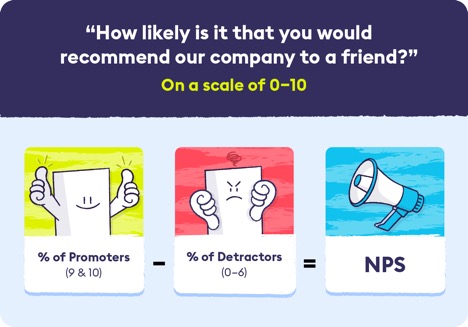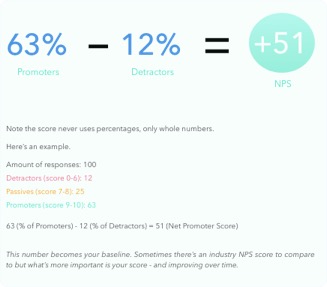Using NPS to Both Measure Brand Image and Protect Reputation
When it comes to running a successful company, customer satisfaction is one of the most important elements to keep in mind for obvious reasons. A satisfied customer is a customer who is more likely to be loyal to your brand. They are also more likely to recommend your brand to others, therefore improving your brand’s reputation and your likelihood to attract new buyers.
One metric to measure customer satisfaction is Net Promoter Score (NPS). You can use NPS to quantify your customer loyalty and leverage that data to improve both your customer satisfaction initiatives as well as the likelihood of your customers promoting your brand to others. In the process, you’ll boost your brand’s image and trustworthiness.
- What is Net Promoter Score?
- How is Net Promoter Score calculated?
- How companies can improve their brand image with NPS
What is Net Promoter Score?
Net Promoter Score is a measurement used to better understand customer experience and business growth. It is one of the most popular ways to measure online sentiment.
NPS is a relatively new concept—it was introduced in 2003 by Frederick F. Reichheld, who discussed the process of arriving at the metric in his article “The One Number You Need to Grow.” Reichheld and his team conducted two years of research, measuring the relationship between customers’ survey responses and their actual referral and purchase behavior.
There was one question in particular that correlated directly with differences in growth rates amongst competitors in multiple industries: “How likely is it that you would recommend [company X] to a friend or colleague?” This question became the basis of NPS.
Since the introduction of NPS, it has become a popular method of measuring and improving customer loyalty and satisfaction. Its popularity is a product of NPS’s proven ability to bolster company profit and growth. The simplicity of NPS also makes it an appealing and easy metric to use.
NPS is an uncomplicated yet effective way for you to gather data about your company’s strengths and weaknesses from a customer’s perspective. Communicating with your customers about these strengths and weaknesses allows you to pinpoint how to increase customer loyalty, improve your brand’s image, and ultimately grow your business.
How is Net Promoter Score calculated?
Image source: Chattermill.com
For such a valuable and effective metric, the process of calculating NPS is pretty simple—all you need is an email campaign service and access to your customers’ contact information.
Here’s how you can calculate your company’s NPS in just three simple steps:
Step 1. Gather customer data via an NPS survey
To calculate NPS, you’ll need to determine how loyal your customers are. To do this, you can gather customer data via an NPS survey that asks, “How likely are you to recommend our product to a friend or colleague?” The response options should be on a scale of 1 to 10, with 1 being “Not at all likely,” and 10 being “Extremely likely.”
Step 2. Categorize responses into detractors, passives, and promoters
After you’ve gathered customer loyalty data, you can group responses into three different categories based on where they fall on the 10-point scale:
- Detractors = 0-6
- Passives = 7-8
- Promoters = 9-10
Detractors are customers who are not satisfied, not loyal to your company, and not likely to recommend you to others—they account for more than 80% of negative word-of-mouth opinion.
Passives are customers who are satisfied, but not necessarily loyal. Consequently, they will probably not talk much about your brand, hence the label “Passives.”
Promoters are customers who are extremely satisfied, highly loyal to your company, and likely to recommend you to others.
Your goal is to maximize the number of Promoters your company has while also minimizing the number of Detractors.
Step 3. Calculate your company’s NPS
Finally, subtract the percentage of Detractor responses from the percentage of Promoter responses to get a number between -100 and 100, with -100 being the worst NPS and 100 being the best.
A negative NPS means that you have more Detractors than Promoters, indicating that the majority of your customers are dissatisfied with their experience and disloyal to your company. A positive NPS means the opposite—Promoters outnumber Detractors, indicating that the majority of your customers are extremely satisfied and likely to recommend your company to others.
How companies can improve their brand image with NPS
Now that you’ve calculated your company’s NPS, you can leverage the data you’ve gathered to improve your company’s brand image. Calculating your company’s NPS can help you figure out the current state of your brand’s reputation, providing you with a starting point for growth.
The most valuable aspect of NPS is knowing which customers to target when it comes to identifying elements of the customer experience that make your clients happy, as well as those that make them dissatisfied. Promoters help you identify what works so you can continue doing it, while Detractors are valuable for recognizing areas where you need to improve. It is essential that you communicate with these customers to make NPS effective.
As you make changes based on feedback from Promoters and Detractors, you’ll likely improve your NPS over time. While improving your NPS is exciting, especially since the metric correlates with revenue growth, it’s important to keep in mind that the ultimate goal is to translate the insight you glean from NPS into business growth. So make sure your focus is on learning and improving, and not just superficially improving your NPS.
Once your company has an NPS you’re proud of, you can even publish it to help customers view you as trustworthy. A high NPS signals that customers are satisfied with their experience and would recommend your business, making potential customers more likely to try out your product and existing customers more assured that they are using a quality product that others approve of.
Determining your company’s Net Promoter Score is valuable for developing a better understanding of the elements of your business that keep your customers loyal, satisfied, and eager to recommend your brand to others. This understanding can lead to increased business growth and revenue as you communicate with your customers and learn from the data you gather. Net Promoter Score is a simple yet effective way for your company to improve, so it’s definitely worth exploring.
Net Promoter Score FAQs
What is Net Promoter Score?
Net Promoter Score is a measurement used to better understand customer experience and business growth. It is one of the most popular ways to measure online sentiment.
What are the benefits of a good Net Promoter Score?
A high Net Promoter Score (NPS) means a large percentage of your customers feel so positively about your business that they are willing to share their positive sentiment and recommend your business to other people. That’s practically the dictionary definition of a good company reputation.
How reliable is Net Promoter Score?
It depends. As a metric of how your customers are feeling about your brand, NPS is a clear, straightforward, useful value that can be measured and improved. However, it can be hard to tease apart intertwined measurements such as customer satisfaction and loyalty. It does not necessarily indicate that your customers will boost your brand’s reputation, even if they are big fans.
Tags: Business Reputation Repair, Reputation Marketing, Review Management.



